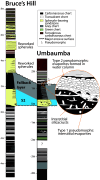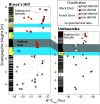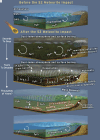Effect of a giant meteorite impact on Paleoarchean surface environments and life
- PMID: 39432780
- PMCID: PMC11536127
- DOI: 10.1073/pnas.2408721121
Effect of a giant meteorite impact on Paleoarchean surface environments and life
Abstract
Large meteorite impacts must have strongly affected the habitability of the early Earth. Rocks of the Archean Eon record at least 16 major impact events, involving bolides larger than 10 km in diameter. These impacts probably had severe, albeit temporary, consequences for surface environments. However, their effect on early life is not well understood. Here, we analyze the sedimentology, petrography, and carbon isotope geochemistry of sedimentary rocks across the S2 impact event (37 to 58 km carbonaceous chondrite) forming part of the 3.26 Ga Fig Tree Group, South Africa, to evaluate its environmental effects and biological consequences. The impact initiated 1) a giant tsunami that mixed Fe2+-rich deep waters into the Fe2+-poor shallow waters and washed debris into coastal areas, 2) heating that caused partial evaporation of surface ocean waters and likely a short-term increase in weathering and erosion on land, and 3) injection of P from vaporization of the S2 bolide. Strata immediately above the S2 impact event contain abundant siderites, which are associated with organic matter and exhibit light and variable δ13Ccarb values. This is consistent with microbial iron cycling in the wake of the impact event. Thus, the S2 impact likely had regional, if not global, positive and negative effects on life. The tsunami, atmospheric heating, and darkness would likely have decimated phototrophic microbes in the shallow water column. However, the biosphere likely recovered rapidly, and, in the medium term, the increase in nutrients and iron likely facilitated microbial blooms, especially of iron-cycling microbes.
Keywords: Archean; early Earth; habitability; meteorite impact.
Conflict of interest statement
Competing interests statement:The authors declare no competing interest.
Figures








References
-
- Toon O. B., Zahnle K., Morrison D., Turco R. P., Covey C., Environmental perturbations caused by the impacts of asteroids and comets. Rev. Geophys. 35, 41–78 (1997).
-
- Segura T. L., Zahnle K., Toon O. B., McKay C. P., “The effects of impacts on the climates of terrestrial planets” in Comparative Climatology of Terrestrial Planets, Mackwell S. J., Simon-Miller A. A., Harder J. W., Bullock M. A., Eds. (University of Arizona Press, 2013), pp. 417–437.
-
- Schulte P., et al. , The chicxulub asteroid impact and mass extinction at the Cretaceous-Paleogene boundary. Science 327, 1214–1218 (2010). - PubMed
-
- Sleep N. H., Zahnle K. J., Kasting J. F., Morowitz H. J., Annihilation of ecosystems by large asteroid impacts on the early Earth. Nature 342, 139–142 (1989). - PubMed
-
- Kring D. A., Environmental consequences of impact cratering events as a function of ambient conditions on earth. Astrobiology 3, 133–152 (2004). - PubMed
MeSH terms
Substances
Grants and funding
LinkOut - more resources
Full Text Sources

